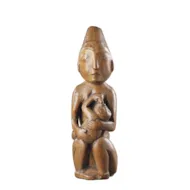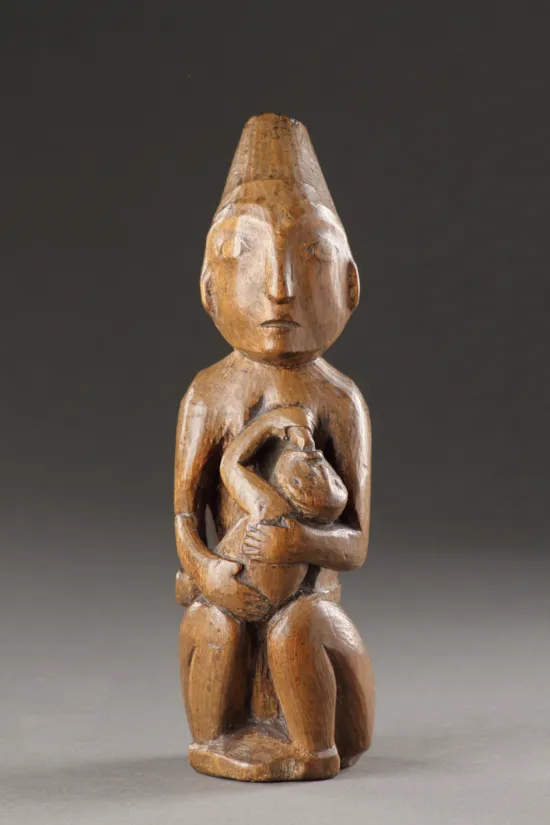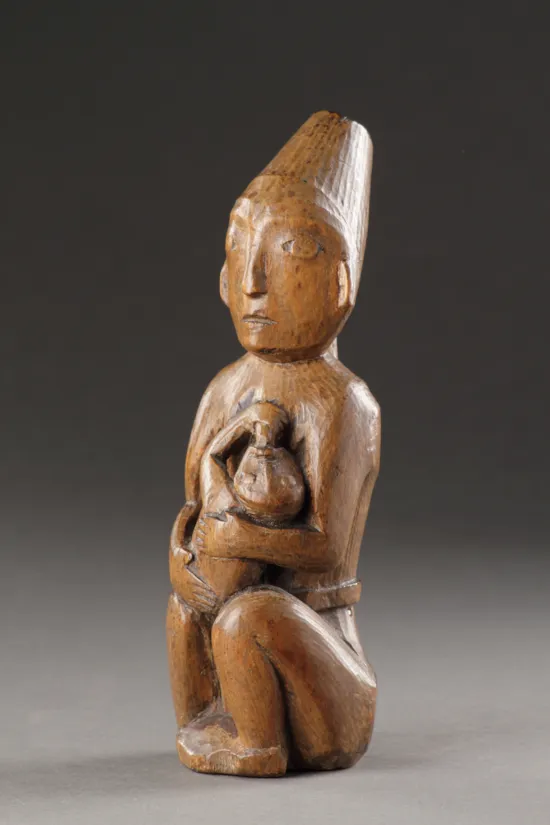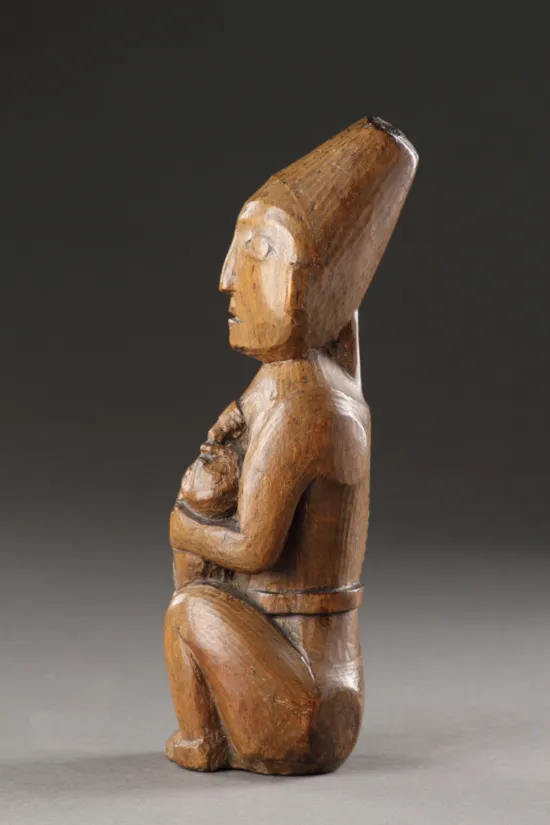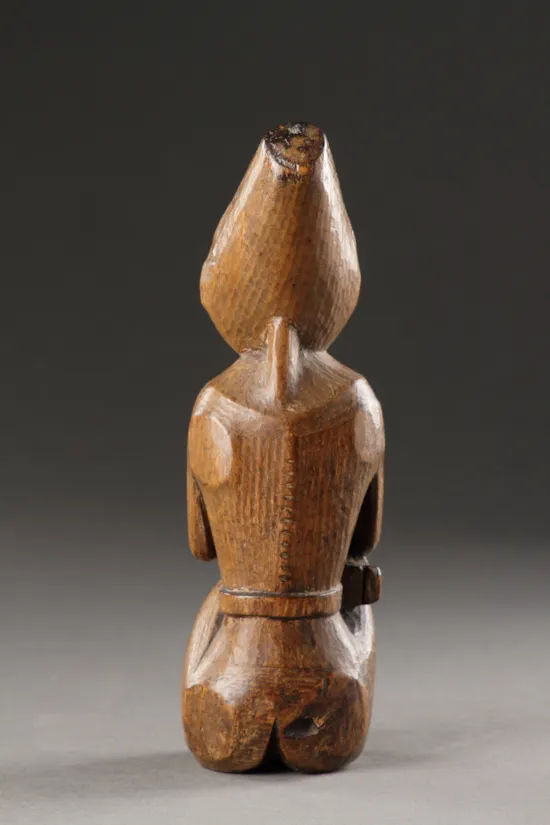A Very Rare and Early Northwest Coast Maternity Figure
An Over Life-Size Powerful Roman Male Portrait Head of Constantine the Great (c.272 - 337)
Wearing the ‘Imperial Oak Wreath’ the decorative border of his ‘tunic’ can still be clearly seen on the left hand side
Marble
Italy
Early 4th Century AD
SIZE: 38cm high, 24.5cm wide, 25cm deep - 15cm high, 9¾ ins wide, 10 ins deep
Wearing the ‘Imperial Oak Wreath’ the decorative border of his ‘tunic’ can still be clearly seen on the left hand side
Marble
Italy
Early 4th Century AD
SIZE: 38cm high, 24.5cm wide, 25cm deep - 15cm high, 9¾ ins wide, 10 ins deep
A Very Rare and Early Northwest Coast Maternity Figure
Aged patina through handling
Wood
Kwakiutl (Kwakwaka ‘wakw’) Northwest Coast America / Nootka
19th Century
SIZE: 20cm high - 8 ins high
Aged patina through handling
Wood
Kwakiutl (Kwakwaka ‘wakw’) Northwest Coast America / Nootka
19th Century
SIZE: 20cm high - 8 ins high
The elegant seated female figure holds her baby upon her knees, cradling the suckling infant’s head. The female figure displays a very distinctive ‘conical’ shaped hair-style, although the domed forehead, which was flattened artificially, was practiced by the Kosimo (Salish).
The Kwakiutl are one of several indigenous First Nations that inhabit the western coast of British Columbia, Canada, from central and northern Vancouver Island to the adjacent mainland coast.
The Kwakwaka'wakw, or ‘Kwak´wala-speaking people’, live along the Pacific Northwest coast of British Columbia. The tribes once numbered twenty-eighty, who lived on northern Vancouver Island and the adjacent mainland. They are known for the ‘potlatch’ ceremony which in Kwak'waka literally means ‘to give’. The ceremony marks all the important moments in the life of the Kwakwaka’wakw: birth, marriage and death in particular. It is a jubilant celebration organised by the chief of a tribe or a host, during which offerings are offered, masks exhibited and dances staged.
Much of our early knowledge about the Kwakiutl is attributed to Franz Boas (1858 - 1943), and his close associate George Hunt (1854 - 1933). Boas, the first, and perhaps most famous, anthropologist to work with the Kwakiutl, conducted intermittent field work in the Northwest Coast between 1885 and 1930, engaging in ethnographic interviews, compiling myths and oral histories, charting Kwakiutl social and political organisation, and observing festivals and ceremonies. However, not without controversy, Boas was also an active collector of native skeletons used in early scientific research. George Hunt, a Kwakiutl considered by some to be among the first indigenous anthropologists, described himself as a ‘collector’ and served as a translator and guide for Boas and several other prominent anthropologists engaged in ethnography and collecting, including the renowned photographer Edward Curtis and anthropologist Samuel A. Barrett.
The Kwakiutl are one of several indigenous First Nations that inhabit the western coast of British Columbia, Canada, from central and northern Vancouver Island to the adjacent mainland coast.
The Kwakwaka'wakw, or ‘Kwak´wala-speaking people’, live along the Pacific Northwest coast of British Columbia. The tribes once numbered twenty-eighty, who lived on northern Vancouver Island and the adjacent mainland. They are known for the ‘potlatch’ ceremony which in Kwak'waka literally means ‘to give’. The ceremony marks all the important moments in the life of the Kwakwaka’wakw: birth, marriage and death in particular. It is a jubilant celebration organised by the chief of a tribe or a host, during which offerings are offered, masks exhibited and dances staged.
Much of our early knowledge about the Kwakiutl is attributed to Franz Boas (1858 - 1943), and his close associate George Hunt (1854 - 1933). Boas, the first, and perhaps most famous, anthropologist to work with the Kwakiutl, conducted intermittent field work in the Northwest Coast between 1885 and 1930, engaging in ethnographic interviews, compiling myths and oral histories, charting Kwakiutl social and political organisation, and observing festivals and ceremonies. However, not without controversy, Boas was also an active collector of native skeletons used in early scientific research. George Hunt, a Kwakiutl considered by some to be among the first indigenous anthropologists, described himself as a ‘collector’ and served as a translator and guide for Boas and several other prominent anthropologists engaged in ethnography and collecting, including the renowned photographer Edward Curtis and anthropologist Samuel A. Barrett.
Adam Prout, UK
Ex Private collection
Ex Private collection
A Very Rare and Early Northwest Coast Maternity Figure
